|
|
Various
Indian tribes, such as the Caddo, Kickapoo, and Cherokee, lived on
the river bottoms among the pine thickets in East
Texas before the Texas Revolution. The Mexican government had
no interest in colonizing East
Texas; therefore, was able to maintain good relations with the
Indians. But with the revolution came immense change, for more than
just Texans and Mexicans. As floods of settlers arrived in the piney
woods the Indians were forced off their lands. President of the Republic
of Texas, Sam Houston,
attempted to maintain relations with the Indians and even entered
into a number of treaties which would guarantee them rights to their
land, but in the end the Texas legislature would not ratify the treaties,
and local authorities and settlers refused to acknowledge the agreement.
After being defeated in 1836, Mexico appealed and campaigned to East
Texas Indians and encouraged them to rise up against the Anglo-Americans
in an attempt to regain the Texas territory.
The Mexican government recruited Indians and Blacks to help them disarm
Texas. In 1838, Houston was replaced as president by Mirabeau
B. Lamar. Lamar had campaigned on the promise of suppressing the
Indians and driving them out of Texas
and received much support from East
Texas. Failure to guarantee the Indians their land made the lush
green piney woods of East
Texas turn red with the blood of early settlers.
Those who stayed behind to hold down the home front in Houston
County saw their share of bloody battles. Almost two centuries
ago, a gruesome massacre occurred in the northeastern portion of the
county, near San Pedro Creek and the Augusta
community, which was established in 1821. The massacre has lived on
as local legend of a tragedy that claimed the lives of many helpless
people. The blood curdling screams of women and children echoed through
the piney woods on that night, October 18, 1838, accompanied by the
war whoops of Indians, in what is known as the Edens-Madden Massacre.
|
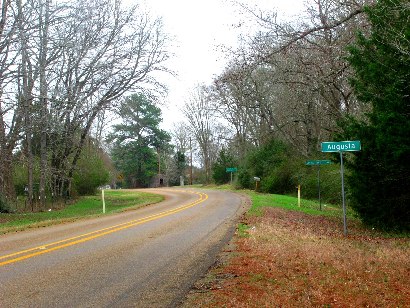 |
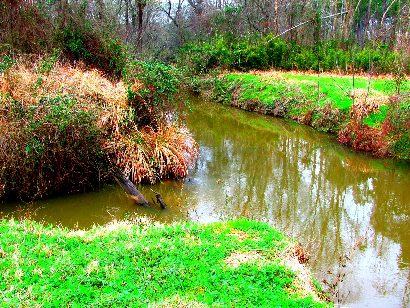 |
It
was a frosty fall night in the San Pedro Creek area, approximately
10 miles east of Grapeland.
Wives and children of soldiers who had been deployed to Ft.
Houston days earlier were gathered in the home of John Edens,
along with other neighboring families including the Maddens, Moores,
and Murchisons. The group had learned of an approaching band of Indians,
and considering the widespread attacks on Anglos in recent months,
had all gathered at the Edens home. The Edens home is said to have
been “two separate dwellings,” while other accounts specify that it
was a classic dogtrot style house. The dogtrot style house was a classic
East Texas farm house
that allowed the cool breeze to air condition the home. At any rate,
both dwellings were used in times of danger. In such times, men would
occupy one building and the women and children would stay in the other.
The Edens homestead was fairly surrounded by multiple Indian tribes.
Indian tribes living in the area around the time of the attack included
the Cherokees, Anadarkos, Caddos, Ionis, and Coushattas. While blame
has been laid on different tribes for the massacre at Edens’, the
tribe most likely responsible is believed to be the Kickapoos. According
to a statement made in the county court of Nacogdoches
in October 1838, a hostage that had been held during the rebellion
by the Mexicans and Indians, stated that the Kickapoos had taken credit
for the attack at Edens’, in Houston
County.
After awhile the anticipation passed and the group began to feel more
at ease. The settlers had kept a sharp eye out for Indians throughout
the day, and there was nothing to indicate the Indians intended to
attack them or were any longer in the vicinity. The group had begun
to relax and move about with less suspicion, and as bedtime neared,
the men and women both retired to their separate dwellings for the
evening, albeit just a breezeway away. |
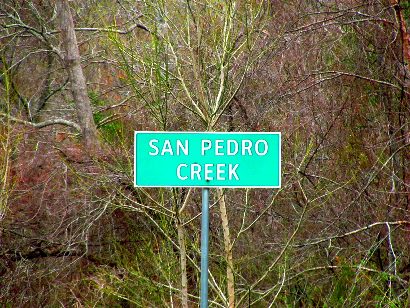 |
The settlers
had underestimated the treachery of the vengeful Indians. Kickapoo
Indian spies had been positioned near and around the house most of
the day. They had been watching the group’s every move and fully understood
how they were positioned and furthermore separated. The Indians waited
patiently until the moment was opportune to launch their full scale
attack. When the Indians saw that the men had retired for the evening
they made their move and advanced on the group’s moment of weakness.
Such was the moment of doom for most of the group. The Indians rushed
into the house, taking the group by complete surprise and cutting
them off from the few men who were in their quarters across the way.
The Indians commenced to unleashing a hideous butchery on the women
and children, which became the dark legend of the Edens-Madden Massacre.
The Indians wasted no time swinging away with their tomahawks, while
other Indians barricaded the doors and stood watch in case any reinforcements
were to arrive.
Different accounts passed down from survivors described over the past
172 years vary. Some accounts describe how the men fought the Indians
with desperation, as only men would fight in their final hours. One
account from a neighbor whose household had fled into the creek bottoms
to take cover in the timber after hearing the war whoops said the
men fought like wild animals at bay; like savages themselves. Other
accounts passed down over the years suggested the men fled the scene
believing all of the women and children were dead.
With no protection and outnumbered, the group could only do their
best then die. The Indians had every advantage in the struggle, and
overpowered the women and children with ferocity. One historian’s
account suggests that the women and children were unable to escape
due to a “powerful and hideous demon,” who blocked the doorway with
his massive body. The Indian in the doorway was said to have been
so large that he could grasps the lintels of the doorway with his
hands. The massive Indian is also said to have yelled with laughter
as he watched his accomplices hack away at the women and children.
Tomahawks and scalping knives were slung unyielding throughout the
room, as the helpless captives were butchered and scalped. Cries for
help resounded through the hollers of the piney woods, and pierced
the night air with terror, but no one came to their aid that night. |
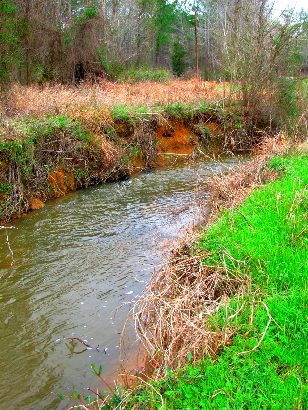 |
The Edens-Madden
Massacre has proven not only to be a tragedy, but a true horror story
that has stood the test of time. Tales of the attack depict a chaotic
and horrific scene. The Indians ripped into the feather beds setting
free thousands of feathers, only adding to the confusion and chaos
in the room. Stories of how “wild” Indians slashed into the defenseless
women and children mercilessly have become legend.
The Indians set fire to everything during the attack by spreading
coals from the fireplace over everything in the room. Children were
thrown into the flames alive and set on fire, others had their heads
beaten in against the log walls of the house. One witness’s account
recalled a woman who had been tomahawked severely and fell dead into
the fireplace after the blow. She was said to have been bleeding so
profusely that her blood extinguished the flames in the fire place,
leaving the Indians to do their work in a dimly lit room.
Mrs. Edens attempted to escape, and succeeded as far as the front
gate before meeting her fate. John Edens was said to have rushed up
on the scene, firing one shot with an old pistol before retreating
into the woods. Assuming all of the women and children were dead he
and the other men fled for safety.
James Madden managed to escape from the house and led several of the
Indians on a lengthy foot pursuit. Madden raced through the pine trees
and over fences until he reached a creek. With the Indians hot on
his heels, Madden took a deep breath and plunged into the cold creek
waters. The Indians did not see him dive into the water and continued
downstream along the creek banks in search of him. |
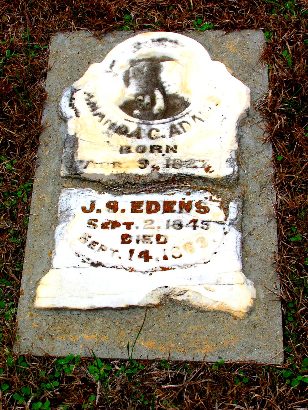 |
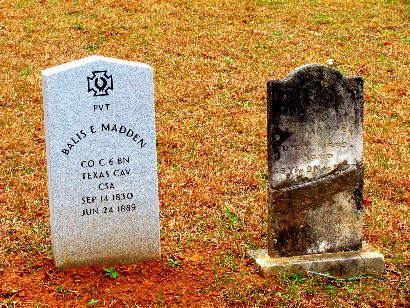 |
Mrs. Madden was
cruelly hacked to pieces. She suffered a severed collarbone from being
chopped with a tomahawk, and a second gash through her ribs, near
her spine. The third and final blow opened a gash in the back of her
head, causing her to fall to the floor. The Indians assumed she was
dead and moved on to killing other women and children. As the Indians
finished off the remaining women and children, Mrs. Madden made her
move.
Legend has it that Mrs. Madden pulled her broken and bleeding body
out of the house, passing through the legs of the large Indian guarding
the front door. In all of the excitement the Indians had failed to
notice her slow moving body dragging across the floor. Mrs. Madden
crawled slowly away from the doomed house and toward the fence, where
she was then rescued by a slave named Patsy. Mrs. Madden’s will to
survive was obviously a trait she passed on to her son Balis as well.
Balis had saved his own life by following his mother and running off
to seek safety among the slaves. Balis later told his own son that
he bedded down with the hogs that night. Mrs. Madden recovered from
her wounds, and often talked about how she had never slept better
in all her life, likely due to extreme blood loss. She lived to be
77 years old.
It is impossible to know how many were killed that October night.
According to the historical marker, all four men escaped, as well
as two small children and two wounded women. Some accounts suggest
multiple children were carried off by the Indians. Before fleeing
the bloody scene, the Indians plundered the home of all its valuables,
and set the house a blaze. They stole all of the guns that the group
had intended to use against them, along with all but one horse that
was tied up near the home. |
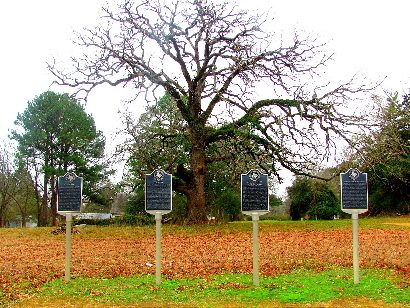 |
Today four historical
markers stand in the bend of the curb in the Augusta
Community, at the site of the massacre. The bodies that were recovered
from the vicious attack are buried in the Augusta
Cemetery, among many other pioneers of Houston
County. The cemetery is located down a red dirt road, CR 1680,
just 3/10 of a mile from FM 227 where the historical markers stand.
The oldest documented grave in the cemetery dates back to 1854. Numerous
infants and young children are resting in the cemetery, along with
multiple pioneers. One young pioneer buried at the site is that of
a young girl who died while traveling with a wagon train. Victims
of the 1918 influenza epidemic and Civil War veterans are also buried
in Augusta. Other graves were never marked or have been lost over
time, but will never be forgotten. While many of those resting in
the Augusta are
older than Texas itself, there are still
Houston County residents being laid to rest among the first pioneers
of Houston County.
© Dana Goolsby
"In The Pines With Dana Goolsby"
March 8, 2011 Column |
|
|
